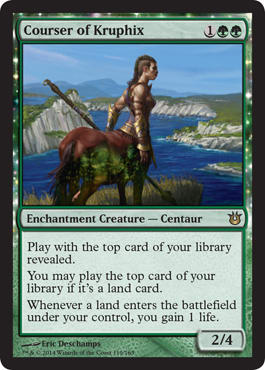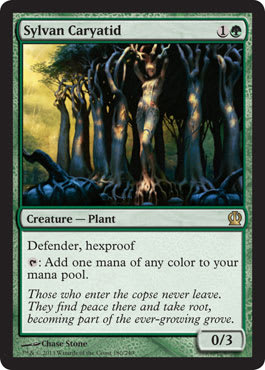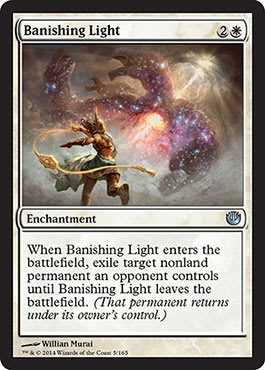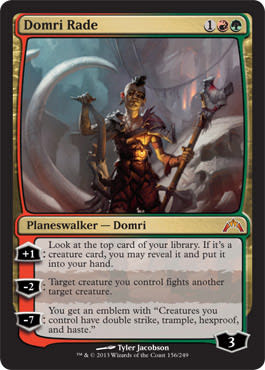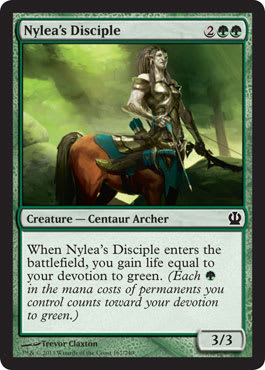I’ve fallen in love with Commander.
It’s such a fun format that is so diverse due to the number of cards at your disposal, and it really tests your deck-building skills since decks are built singleton (only one of each card). Even though it’s a casual format, you can definitely learn some things to take away for other formats.
Why am I talki—
Michael, I think you’re in the wrong section. This is the Standard section!
Don’t worry; I realize that.
Now, as I was saying . . .
Why am I talking about Commander in a Standard article?
The reason is that I just started playing the format, and it’s a breath of fresh air for me. It allowed me to flex my deck-building skills in a new light and bring some of those new ideas to Standard.
Standard was my primary focus ever since I started playing Magic, and frankly, I was starting to become a bit burned out over the past month or so. It felt as though every new deck idea I worked on just wasn’t good enough to write about or failed in testing. Since I produce content for YouTube, Gathering Magic, and Roguedeck-builder, it wasn’t a great place to be in.
Commander gave me a chance to play with cards I’ve never played with before and use cards typically “bad” in Standard that turned out to be good in Commander—even though Commander and Standard are drastically different. Commander taught me new ways to approach not only deck-building, but also the Standard format.
One of the main reasons I started growing burned out when building decks and testing them was the amount of removal in Standard. Many of the interesting decks I had ended up dying out due to the heavy reliance they had on permanents. When using very synergistic strategies, if important pieces of your deck are being removed, the whole deck ends up suffering. There’s a reason W/U/x Control, B/g Devotion, and Burn are just some of the top decks in Standard right now: They use little to no synergy between their cards and just play powerful spells.
Supreme Verdict, Thoughtseize, Lifebane Zombie, Hero's Downfall, Detention Sphere, Banishing Light, Abrupt Decay, and Doom Blade all pressure to keep pumping out enough threats; and those spells I listed are just the tip of the iceberg when it comes to the amount of removal in the format.
Today, I have a deck for you that will make your opponents wish they had more removal.
Resilient Jund ? Journey into Nyx Standard | Michael Yee
- Creatures (27)
- 2 Desecration Demon
- 3 Deadbridge Goliath
- 3 Polis Crusher
- 3 Reaper of the Wilds
- 3 Stormbreath Dragon
- 3 Sylvan Caryatid
- 4 Courser of Kruphix
- 4 Elvish Mystic
- 2 Polukranos, World Eater
- Planeswalkers (5)
- 2 Garruk, Caller of Beasts
- 3 Domri Rade
- Spells (5)
- 1 Golgari Charm
- 2 Abrupt Decay
- 2 Setessan Tactics
- Lands (23)
- 1 Forest
- 2 Mana Confluence
- 4 Blood Crypt
- 4 Overgrown Tomb
- 4 Stomping Ground
- 4 Temple of Abandon
- 4 Temple of Malady
- Sideboard (15)
- 4 Thoughtseize
- 1 Golgari Charm
- 2 Nylea's Disciple
- 3 Mistcutter Hydra
- 2 Mizzium Mortars
- 1 Dreadbore
- 2 Sire of Insanity
One of the things I learned when building my very first Commander deck was trying to squeeze as much value as you can out of each card put into the deck. Since you only use one copy of each card, having each do more than one thing is very important.
This is how I approached building this Standard deck. We have such powerful threats that every single one usually needs an answer. However, the creatures I chose are different enough that they require different spells to answer them while still being large bodies to beat down with. This was another thing I learned from Commander: choosing creatures that have a similar overarching goals (in this case, that’s killing your opponent) yet do a variety of different things at the same time.
Colorwise, Jund gave me access to some of the best monsters in Standard, but the color combination also offers creatures that come with a nice range of effects and abilities.
Creatures
The base of the deck is green since that is where the mana dorks and largest creatures live. Elvish Mystic, Sylvan Caryatid, Courser of Kruphix, and Polukranos, World Eater were all no-brainers.
Elvish Mystic and Sylvan Caryatid help us ramp into our threats and use more of our mana for activating abilities or casting more spells.
Courser of Kruphix is one of the best cards in the format and ensures we keep a steady stream of lands going, with some extra life to sustain against burn. The 2/4 body coming down on turn two or on turn three is also a great roadblock for those hyper-aggressive decks.
Polukranos is the main beatdown creature for any green-based monster deck. It’s a good value being a 5/5 for ![]()
![]()
![]() with a good ability to use against weenie decks. That being said, I’m not a huge fan of having four of him in a deck. His ability is much less effective against any decks playing a low number of creatures, and you only can have one of him on the field, which means it’s a potential dead draw if one’s already in play. His monstrosity is good, but we aren’t using a Nykthos, Shrine to Nyx strategy, so making him larger than life isn’t possible. We have enough threats that using mana to play them is worth more than putting a few counters on Polukranos.
with a good ability to use against weenie decks. That being said, I’m not a huge fan of having four of him in a deck. His ability is much less effective against any decks playing a low number of creatures, and you only can have one of him on the field, which means it’s a potential dead draw if one’s already in play. His monstrosity is good, but we aren’t using a Nykthos, Shrine to Nyx strategy, so making him larger than life isn’t possible. We have enough threats that using mana to play them is worth more than putting a few counters on Polukranos.
This is why I have three Deadbridge Goliaths and two Polukranos, World Eater. The goal of the deck is your basic plan of pumping out threat after threat after threat . . . until your opponent’s dead. But we want threats that come with additional effects to tax our opponent in different ways while still providing big bodies. Deadbridge Goliath is one of my favorite cards in Standard, and since both Deadbridge Goliath and Polukranos have the exact same body for ![]()
![]()
![]() , we’re not losing much from playing the incredible Insect. In fact, I’d say we’re gaining something. The scavenge ability on Deadbridge Goliath allows us to get extra value off him even after he dies.
, we’re not losing much from playing the incredible Insect. In fact, I’d say we’re gaining something. The scavenge ability on Deadbridge Goliath allows us to get extra value off him even after he dies.
9/9 Polis Crusher? Sure, let’s trample over everything.
6/6 Elvish Mystic? Dork turned deadly.
9/10 Reaper of the Wilds? A difficult threat to remove that can hit even harder.
It’s also an ability that is overlooked frequently, so being able to catch your opponent off guard with it is a nice bonus.
Looking at the rest of the creature base, you’ll notice how congested the 4-drop slot is. People might think this is unfavorable for the deck, and normally, you’d be right. However, in this deck, the vast choice of threats we have at 4 mana is the best thing going for this deck.
Because every threat in our deck is a good creature to beat down with, even if all our creatures came with no text boxes, we’d be happy playing them. They’re bodies that are well-valued for their costs, but the abilities and effects they come with are what make this deck so powerful. We have a utility belt of monsters for a variety of situations rather than only playing them as big threats, and each one brings something different to the table, which means we have a chance to dictate how our opponents pace their removal.
Desecration Demon is great to roadblock almost any other threat, and the evasion is a good way for us to race against other creature-based decks. Chump-blocking isn’t as easy against this guy, and while our opponents may sacrifice creatures to try to squeeze damage through, we have plenty more bodies capable of blocking on the ground. Also, thanks to Sylvan Caryatid and Elvish Mystic, a turn three 6/6 flyer definitely pressures any opponent in more ways than one.
Reaper of the Wilds comes with so many attractive abilities that there was no way I wasn’t including her in the deck. A 4/5 for ![]()
![]()
![]() is already good enough to play, and especially with G/W-based decks becoming more common, she dodges Selesnya Charm. Reaper also provides extra value from other creatures dying thanks to scry, which, in combination with cards like Courser of Kruphix and Domri Rade, results in many fixed draws. The deathtouch is nice with Domri’s fight ability or Setessan Tactics if she needs to hit something bigger than she is, but the hexproof is the important part. It provides another layer of protection toward spot removal, reducing the number of options our opponents have for taking out our creatures.
is already good enough to play, and especially with G/W-based decks becoming more common, she dodges Selesnya Charm. Reaper also provides extra value from other creatures dying thanks to scry, which, in combination with cards like Courser of Kruphix and Domri Rade, results in many fixed draws. The deathtouch is nice with Domri’s fight ability or Setessan Tactics if she needs to hit something bigger than she is, but the hexproof is the important part. It provides another layer of protection toward spot removal, reducing the number of options our opponents have for taking out our creatures.
This brings us to our last 4-drop fighter, Polis Crusher.
I originally had Ghor-Clan Rampager in place of Polis Crusher, but when I saw the enchantment-eating Cyclops I asked myself,
“Why is no one playing this card?”
Detention Sphere, Banishing Light, Underworld Connections, and Courser of Kruphix are some of the most-played cards in Standard. Not only can Polis Crusher protect himself from being exiled, it’s an additional way for us to remove them, which means our enchantment-hate cards—Abrupt Decay and Golgari Charm—can be saved for other things if it comes down to that. The inherent trample also comes in handy when using his monstrosity ability, but it also makes the scavenge ability from Deadbridge Goliath even stronger.
Bringing him in during a time when many people are also experimenting with constellation/enchantment decks is also a nice little bonus.
Stormbreath Dragon is another form of evasion for us and another creature with protection. He also helps us curve out very well for a ton of damage if we can go turn-three Desecration Demon into a turn-four Stormbreath Dragon swinging for 10. Originally, I had Arbor Colossus in place of Stormbreath Dragon, but the abilities that came with the Dragon outweighed those on the Colossus.
Non-Creature Spells
I didn’t want to include too many of these since it goes against the deck’s game plan but there were definitely some must-haves.
Domri Rade and Garruk, Caller of Beasts are our card-draw engines. When you’re one-for-one’ing your opponent’s removal, you need some ways of getting ahead. Domri is already among the strongest Planeswalkers in Standard, and with Courser of Kruphix and Reaper of the Wilds, it’s less likely we’ll miss with his +1 ability, so being able to keep drawing into more threats is just what we want. He can also be used as removal with his fight ability since the majority of our creatures are naturally going to be larger than our opponent’s.
Garruk’s pretty self-explanatory when almost all of our deck consists of creatures. He helps keep our hand full. He’s also a bit better than Domri during the late game when we have an increasing chance of being exhausted of threats. His +1 ability can instantly fill our hand back up, and it helps us against other card-advantage engines such as Jace, Architect of Thought, Sphinx's Revelation, and Underworld Connections.
Golgari Charm and Abrupt Decay are extra ways of dealing with problematic enchantments but also can act as removal for smaller creatures—or 1/1 tokens in the case of the Charm. I also wanted Golgari Charm since it can protect us from Wrath effects such as Supreme Verdict or Elspeth, Sun's Champion’s minus ability.
Setessan Tactics acts as Wrath/removal for this deck. When we want to have as many large threats as possible, we want a way to board-wipe rather than using up card slots with spot removal. It also gives us a way to deal with Pack Rat, both early on or even later in the game if we have enough creatures on board.
Sideboard
The sideboard is mostly for control since I prefer not having mana dorks in against decks that play Supreme Verdict. We’ll swap them out for more threats and some hand disruption.
Otherwise, we have more tools at our disposal to help against a variety of decks. For example, Burn is an aggressive deck, and there are going to be times we’ll be under the gun. One Nylea's Disciple can help us get back in the race.
Typically, you’ll create the sideboard depending on what your meta is and what you expect to go up against, so it’s difficult to recommend things to other people. I chose cards that are strong against the top-tier decks while also throwing in some cards that are good in a variety of situations (Mizzium Mortars, Hero's Downfall, extra Golgari Charm). If I had no idea what to expect at a tournament, I would run what I have listed above, but for others, always make sure to do your research on the meta and possible weak matchups.
Moving forward, I have high hopes for this deck. I believe it’s a very good choice given how removal-heavy Standard is right now. It has plenty of power and enough ways to defend itself without sacrificing that much, and by playing some hidden gems such as Polis Crusher and Deadbridge Goliath, you can be sure this deck will take opponents by surprise!
- Michael Y.













